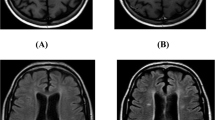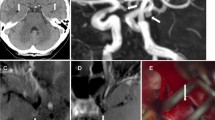Abstract
A variety of central nervous system (CNS) diseases are associated with abnormal hyperintensity within the subarachnoid space (SAS) by fluid-attenuated inversion-recovery (FLAIR) MR imaging. Careful attention to the SAS can provide additional useful information that may not be available with conventional MR sequences. The purpose of this article is to provide a pictorial essay about CNS diseases and FLAIR images with abnormal hyperintensity within the SAS. We present several CNS diseases including subarachnoid hemorrhage, meningitis, leptomeningeal metastases, acute infarction, and severe arterial occlusive diseases such as moyamoya disease. We also review miscellaneous diseases or normal conditions that may exhibit cerebrospinal fluid hyperintensity on FLAIR images. Although the detection of abnormal hyperintensity suggests the underlying CNS diseases and narrows differential diagnoses, FLAIR imaging sometimes presents artifactual hyperintensity within the SAS that can cause the misinterpretation of normal SAS as pathologic conditions; therefore, radiologists should be familiar with such artifactual conditions as well as pathologic conditions shown as hyperintensity by FLAIR images. This knowledge is helpful in establishing the correct diagnosis.












Similar content being viewed by others
References
Hajnal JV, Bryant DJ, Kasuboski I et al. (1992) Use of fluid-attenuated inversion recovery (FLAIR) pulse sequences in MRI of the brain. J Comut Assist Tomogr 16:841–844
Brant-Zawadzki M, Atkinson D, Detrick M et al. (1996) Fluid-attenuated inversion recovery (FLAIR) for assessment of cerebral infarction. Initial clinical experience in 50 patients. Stroke 27:1187–1191
Maeda M, Tartaro A, Matsuda T, Ishii Y (1995) Cortical and subcortical tubers in tuberous sclerosis and FLAIR sequence. J Comut Assist Tomogr 19:660–661
Tsuchiya K, Inaoka S, Mizutani Y, Hachiya J (1997) Fast fluid-attenuated inversion recovery MR of intracranial infections. AJNR 18:909–913
Essig M, Hawighorst H, Oshoenberg SO et al. (1998) Fast fluid-attenuated inversion-recovery (FLAIR) MRI in the assessment of intraaxial brain tumors. J Magn Reson Imaging 8:789–798
Casey SO, Sampaio RC, Michel E, Truwit CL (2000) Posterior reversible encephalopathy syndrome: utility of fluid-attenuated inversion recovery MR imaging in the detection of cortical and subcortical lesions. AJNR 21:1199–1206
Noguchi K, Ogawa T, Inugami A et al. (1995) Acute subarachnoid hemorrhage: MR imaging with fluid-attenuated inversion-recovery pulse sequences. Radiology 196:773–777
Tsuchiya K, Katase S, Yoshino A, Hachiya J (2000) Pre- and postcontrast FLAIR MR imaging in the diagnosis of intracranial meningeal pathology. Radiat Med 18:363–368
De Cone B, Hajnal JV, Gatehouse P et al. (1992) MR of the brain using fluid-attenuated inversion recovery (FLAIR) pulse sequence. AJNR 13:1555–1564
Rydberg JN, Hammond CA, Grimm RC et al. (1994) Initial clinical experience in MR imaging of the brain with a fast fluid-attenuated inversion-recovery pulse sequence. Radiology 193:173–180
Atlas SW (1993) MR imaging is highly sensitive for acute subarachnoid hemorrhage...not! Radiology 186:319–332
Parizel PM, Makkat S, Miert EV et al. (2001) Intracranial hemorrhage: principles of CT and MRI interpretation. Eur Radiol 11:1770–1783
Fabry ME, Eisenstadt M (1978) Water exchange across red cell membranes. Part II. Measurements by nuclear magnetic resonance T1, T2, and T12 hybrid relaxation. The effects of osmolarity, cell volume, and medium. J Membr Biol 42:375–398
Noguchi K, Ogawa T, Seto H et al. (1997) Subacute and chronic subarachnoid hemorrhage: diagnosis with fluid-attenuated inversion-recovery MR imaging. Radiology 203:257–262
Mitchell P, Wilkinson ID, Hoggard N et al. (2001) Detection of subarachnoid haemorrhage with magnetic resonance imaging. J Neurol Neurosurg Psychiatry 70:205–211
Chang K, Han M, Kim I et al. (1990) Gd-DTPA enhanced MR imaging of the brain in patients with meningitis: evaluation and comparison with CT. AJNR 11:69–76
Ginsberg L (1994) Contrast enhancement in meningeal and extra-axial disease. Neuroimaging Clin N Am 4:133–152
Melhelm ER, Jara H, Eustace S (1997) Fluid-attenuated inversion-recovery MR imaging: identification of protein concentration thresholds for CSF hyperintensity. Am J Roentgenol 169:859–862
Singer MB, Atlas SW, Drayer BP (1998) Subarachnoid space disease: diagnosis with fluid-attenuated inversion-recovery MR imaging and comparisons with gadolinium-enhanced spin-echo MR imaging: blinded reader study. Radiology 208:417–422
Mathews VP, Caldemeyer KS, Lowe MJ et al. (1999) Brain: gadolinium-enhanced fast fluid-attenuated inversion-recovery MR imaging. Radiology 211:257–263
Jackson EF, Hayman LA (2000) Meningeal enhancement on fast FLAIR images [letter]. Radiology 215:922–924
Grossman SA, Krabak MJ (1999) Leptomeningeal carcinomatosis. Cancer Treat Rev 25:103–111
Tsuchiya K, Katase S, Yoshino A et al. (2001) FLAIR MR imaging for diagnosing intracranial meningeal carcinomatosis. Am J Roentgenol 176:1585–1588
Singh SK, Agris JM, Leeds N, Ginsberg LE (2000) Intracranial leptomeningeal metastases: comparison of depiction at FLAIR and contrast-enhanced MR imaging. Radiology 217:50–53
Misaki K, Nakada M, Hayashi Y et al. (2001) Contrast-enhanced fluid attenuated inversion recovery MRI is useful to detect the CSF dissemination of glioblastoma. J Comput Assist Tomogr 25:953–956
Tsuchiya K, Katase S, Yoshino A, Hachiya J (1999) Use of contrast-enhanced fluid attenuated inversion recovery magnetic resonance imaging in the diagnosis of metastatic brain tumors. Int J Neuroradiol 5:9–15
Singh SK, Leeds NE, Ginsberg LE (2002) MR imaging of leptomeningeal metastases: comparison of three sequences. AJNR 23:817–821
Makkat S, Vandevenne JE, Verswijvel G et al. (2002) Signs of acute stroke seen on fluid-attenuated inversion recovery MR imaging. Am J Roentgenol 179:237–243
Maeda M, Koshimoto Y, Uematsu H et al. (2001) Time course of arterial hyperintensity with fast fluid-attenuated inversion-recovery imaging in acute and subacute middle cerebral arterial infarction. J Magn Reson Imaging 13:987–990
Toyoda K, Ida M, Fukuda K (2001) Fluid-attenuated inversion-recovery intraarterial signal: an early sign of hyperacute cerebral ischemia. AJNR 22:1021–1029
Maeda M, Yamamoto T, Daimon S et al. (2001) Arterial hyperintensity on fast fluid-attenuated inversion recovery images: a subtle finding for hyperacute stroke undetected by diffusion-weighted MR imaging. AJNR 22:632–636
Noguchi K, Ogawa T, Inugami A et al. (1997) A comparison of FLAIR and T2-weighted fast spin echo images. Neuroradiology 39:406–410
Cosnard G, Duprez T, Grandin C et al. (1999) Fast FLAIR sequence for detecting major vascular abnormalities during the hyperacute phase of stroke: a comparison with MR angiography. Neuroradiology 41:342–346
Kamran S, Bates V, Bakshi R et al. (2000) Significance of hyperintense vessels on FLAIR in acute stroke. Neurology 55:265–269
Mueller DP, Yuh WTC, Fisher D et al. (1993) Arterial enhancement in acute cerebral ischemia: clinical and angiographic correlation. AJNR 14:661–668
Maeda M, Maley J, Crosby DL et al. (1997) Application of contrast agents in the evaluation of stroke: conventional MR and echo-planar MR imaging. J Magn Reson Imaging 7:23–28
Maeda M, Tsuchida C (1999) "Ivy sign" on fluid-attenuated inversion-recovery images in childhood moyamoya disease. AJNR 20:1836–1838
Yoon HK, Shin HJ, Chang YW (2002) "Ivy sign" in childhood moyamoya disease: depiction on FLAIR and contrast-enhanced T1-weighted MR images. Radiology 223:384–389
Dechambre SD, Duprez T, Grandin CB et al. (2000) High signal in cerebrospinal fluid mimicking subarachnoid hemorrhage on FLAIR following acute stroke and intravenous contrast medium. Neuroradiology 42:608–611
Bozzao A, Floris R, Fasoli F, Fantozzi LM, Colonnese C, Simonetti G (2003) Cerebrospinal fluid changes after intravenous injection of gadolinium chelate: assessment by FLAIR MR imaging. Eur Radiol 13:592–597
Bozzao A, Bastianello S, Bozzao L (1997) Superior sagittal sinus thrombosis with high-signal-intensity CSF mimicking subarachnoid hemorrhage on MR FLAIR images. Am J Roentgenol 169:1183–1184
Taoka T, Yuh WTC, White ML et al. (2001) Sulcal hyperintensity on fluid-attenuated inversion recovery MR images in patients without apparent cerebrospinal fluid abnormality. Am J Roentgenol 176:519–524
Deliganis AV, Fisher DJ, Lam AM et al. (2001) Cerebrospinal fluid signal intensity increase on FLAIR MR images in patients under general anesthesia: the role of supplemental O2. Radiology 218:152–156
Fillipi CG, Ulug AM, Lin D et al. (2001) Hyperintense signal abnormality in subarachnoid spaces and basal cisterns on MR images of children anesthetized with propofol: new fluid-attenuated inversion recovery finding. AJNR 22:394–399
Stoner T, Braff S, Khoshyomn S (2002) High signal in subarachnoid spaces on FLAIR MR images in an adult with propofol sedation. Neurology 23:292
Admas JG, Melhem ER (1999) Clinical usefulness of T2-weighted fluid-attenuated inversion recovery MR imaging of the CNS. Am J Roentgenol 172:529–536
Bakshi R, Caruthers SD, Janardan V, Wasay M (2000) Intraventricular CSF pulsation artifacts on fast fluid-attenuated inversion-recovery MR images: analysis of 100 consecutive normal studies. AJNR 21:503–508
Herlihy AH, Hajnal JV, Curati WL et al. (2001) Reduction of CSF and blood flow artifacts on FLAIR images of the brain with k-space reordered by inversion time at each slice position (KRISP). AJNR 22:896–904
Acknowledgement
We thank T. Ogawa and G. Asanuma for their technical assistance.
Author information
Authors and Affiliations
Corresponding author
Rights and permissions
About this article
Cite this article
Maeda, M., Yagishita, A., Yamamoto, T. et al. Abnormal hyperintensity within the subarachnoid space evaluated by fluid-attenuated inversion-recovery MR imaging: a spectrum of central nervous system diseases. Eur Radiol 13 (Suppl 6), L192–L201 (2003). https://doi.org/10.1007/s00330-003-1877-9
Received:
Revised:
Accepted:
Published:
Issue Date:
DOI: https://doi.org/10.1007/s00330-003-1877-9




